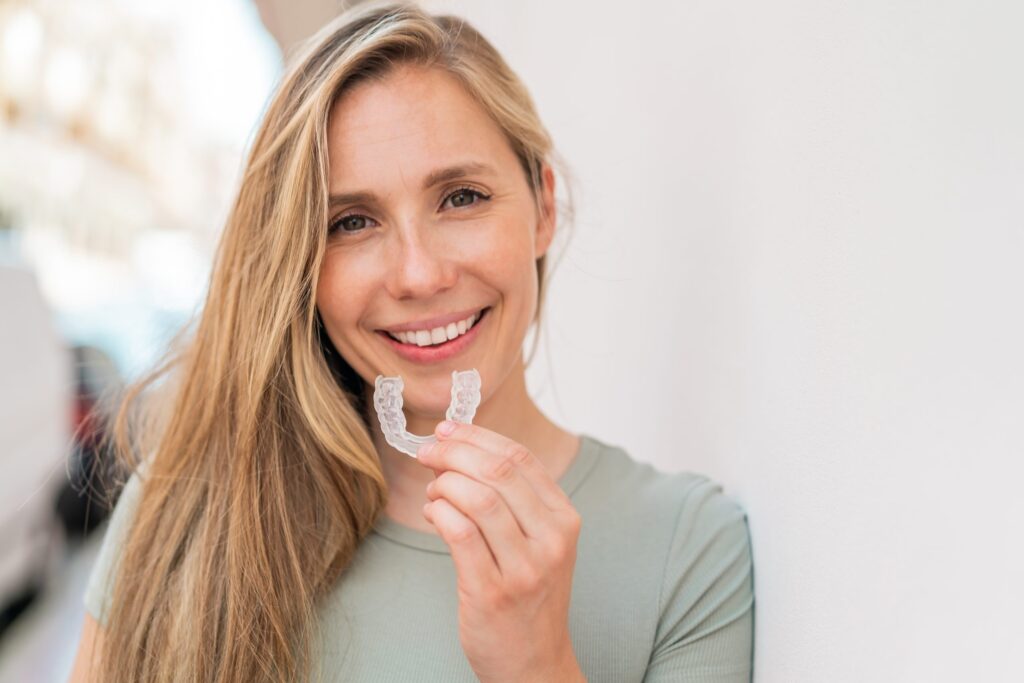Dental veneers have become a lot more popular lately! If you’re on TikTok, Instagram or Facebook, you’ve probably seen some of your favorite ‘influencers’ sporting new veneer smiles.
Are you considering veneers for yourself? Are porcelain veneers a good alternative to Invisalign® or BRIUS® braces treatment?
We’re here to help you understand the realities of dental veneers, so you can make an educated decision on the best treatment route to help you achieve a stunning smile in 2024. Let’s dive into Invisalign vs. braces vs. veneers!
What are dental veneers?
Dental veneers are the most common treatment in cosmetic dentistry. Veneers are typically made out of a tooth-colored porcelain or resin material, and they’re designed to look identical to a healthy natural tooth.
Now more than ever, people are using dental veneers to conceal cosmetic imperfections, like discoloration, chips and cracks in teeth.
Invisalign Vs. Braces Vs. Veneers: What’s the difference?
The main difference between Invisalign/BRIUS braces and veneers (in terms of how these treatments improve the smile) is that dental veneers are cosmetic-focused, whereas Invisalign/braces are orthodontic treatments that alter the foundation or structure of your smile.
- Dental veneers will improve blemishes and textural issues, covering your natural teeth, to improve the appearance of the smile.
- Invisalign and BRIUS braces change the structure of your natural smile – from the jaw bones to the crowns of the teeth – which, in turn, improves the appearance of the smile.
For this reason, veneers and Invisalign/braces have two very different jobs. Conditions that are purely cosmetic and don’t require any changes in the positions of the teeth or jaw bones can be covered with a dental veneer.
Conditions that originate in the jaw position or dental alignment should be taken care of by our experienced orthodontist, Dr. Matsumoto.
If your smile aesthetic during orthodontic treatment is your concern, we encourage you to learn more about Invisalign and BRIUS! Invisalign is virtually-invisible when it’s in place, and BRIUS braces are truly invisible. BRIUS is attached to the hidden, back surfaces of your teeth and can’t be seen when you smile.
Should I get veneers, Invisalign or BRIUS braces?
The best treatment option for you will depend on your specific concerns about your current smile and your goals with treatment. There are pros and cons to all treatment options (like most things in life), so it’s important that you know the facts before you make a decision.
Dental veneers, braces and Invisalign are all highly effective treatment options to help people regain confidence in their smile. However, there are situations or conditions that are best treated with veneers – and conditions that would benefit more from a personalized orthodontic treatment plan from Matsumoto Orthodontics & Periodontics.
Situations where a dental veneer may be the best solution:
- You have a chipped or cracked tooth or teeth
- Your teeth are discolored
- You have irregularly shaped teeth: some teeth are smaller or have an abnormal shape
Situations where Invisalign or BRIUS braces may be the best solution:
- You have crooked or crowded teeth
- You have a bite misalignment: overbite, underbite, open bite, cross bite
- You have gapped teeth or spacing between teeth
- Your top and bottom teeth don’t meet in the front or back properly
- You have functional issues: pain or difficulty chewing or biting
- You’re self-conscious of your smile
How long do veneers last?
On average, dental veneers made with composite material will last for about 5 years before they need to be replaced. Porcelain veneers can last about 10 years. If your veneer wears down early on, or you chip or crack the veneer, you may require a replacement sooner.
Veneers are porcelain and can shatter from excessive pressure, so it’s important to be cautious when chewing and biting into food with veneers.
Veneers are not permanent, but they are also not reversible. In order to attach veneers to your teeth, your dentist will have to shave down a portion of your enamel to allow enough space for the veneer material to fit.
Unfortunately, enamel does not regenerate on its own. Once it’s destroyed, it’s gone for good! Because the enamel is the protective barrier for the teeth, when the enamel is destroyed, it leaves the teeth vulnerable to damage and tooth decay.
How long do Invisalign/BRIUS braces results last?
Your new smile made from BRIUS, braces or Invisalign treatment is designed to last the rest of your life! As long as you wear your retainer as instructed, you shouldn’t have to undergo another ortho treatment in the future.
Orthodontic treatment is basically a one-and-done situation that leaves you with your natural smile, whereas dental veneers will need care for a lifetime. A dental veneer smile is also not as natural-looking as a smile perfected through orthodontics.
Can I get veneers instead of Invisalign/braces?
Veneers cannot replace the need for Invisalign/BRIUS, and vice versa. Both treatments play different roles in repairing the appearance of the smile. If you have an orthodontic issue and require orthodontic treatment, dental veneers will not be a sufficient solution.
Misalignments in the teeth originate in the jaws. In cases where the upper jaw bone is too narrow to fit all teeth in a healthy alignment, this can cause the teeth to overlap and crowd each other. Simply placing veneer shells over crowded teeth or using them to fill in gaps that are the result of a jaw bone misalignment will not treat the source of the problem.
All of the challenging symptoms that come with dental misalignments (difficulty chewing food, jaw pain or popping, speech difficulties) will still be present if they aren’t corrected. Braces and Invisalign can correct these conditions, treat them at the source, and result in a beautifully balanced smile.
Cost of orthodontics vs. cost of veneers
Orthodontic treatment can also be a heck of a lot cheaper than a full smile of veneers! Dental veneers can cost anywhere from $500 to a whopping $2,500 per tooth, depending on the material.
A full set of veneers can range anywhere from $8,000 to $20,000!
Comprehensive orthodontic treatment, on the other hand, averages around $5,000 – $7,000 before insurance coverage. Many insurance plans will cover a portion of your cost! Please know that your out-of-pocket orthodontics cost may be more or less than the average; it depends on your unique needs as well as your insurance coverage.
At Matsumoto Orthodontics & Periodontics, it’s important to us that you have access to expert orthodontic care at a price that works for you. We offer flexible financing, including in-house financing and third party financing with LendingPoint.
On your first visit, we’ll work out a custom financing plan that suits your budget.
Still have questions about veneers vs Invisalign or BRIUS braces?
Basically, if your healthy teeth are crooked, it’s best to invest the time and straighten them with orthodontics instead of cutting them down for veneers!
If you still aren’t sure whether Invisalign, braces or veneers are best for your case, we encourage you to request a complimentary consultation with us. We offer you a free consultation with a comprehensive orthodontic exam from a 5-star orthodontist, because we want you to make the best decision for your smile!
Please don’t hesitate to reach out to us with any questions. Request your complimentary consultation at our Porters Neck, Wilmington orthodontist office today!






